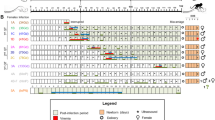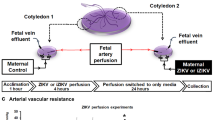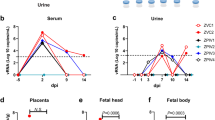Abstract
Zika virus (ZIKV) infection is associated with congenital defects and pregnancy loss. Here, we found that 26% of nonhuman primates infected with Asian/American ZIKV in early gestation experienced fetal demise later in pregnancy despite showing few clinical signs of infection. Pregnancy loss due to asymptomatic ZIKV infection may therefore be a common but under-recognized adverse outcome related to maternal ZIKV infection.
This is a preview of subscription content, access via your institution
Access options
Access Nature and 54 other Nature Portfolio journals
Get Nature+, our best-value online-access subscription
$29.99 / 30 days
cancel any time
Subscribe to this journal
Receive 12 print issues and online access
$209.00 per year
only $17.42 per issue
Buy this article
- Purchase on Springer Link
- Instant access to full article PDF
Prices may be subject to local taxes which are calculated during checkout

Similar content being viewed by others
References
Schaub, B. et al. Eur. J. Obstet. Gynecol. Reprod. Biol. 207, 240–241 (2016).
Brasil, P. et al. N. Engl. J. Med. 375, 2321–2334 (2016).
Subissi, L. et al. Int J. Infect. Dis. 65, 116–118 (2017).
van der Eijk, A. A. et al. N. Engl. J. Med. 375, 1002–1004 (2016).
Esposito, D. L. et al. Am. J. Trop. Med. Hyg. 97 (Suppl. 5), 1959 (2017).
Hoen, B. et al. N. Engl. J. Med. 378, 985–994 (2018).
Pouliot, S. H. et al. Obstet. Gynecol. Surv. 65, 107–118 (2010).
Carter, A. M. et al. Best. Pract. Res Clin. Obstet. Gynaecol. 25, 249–257 (2011).
Dudley, D. M. et al. Nat. Commun. 7, 12204 (2016).
Nguyen, S. M. et al. PLoS Pathog. 13, e1006378 (2017).
Adams Waldorf, K. M. et al. Nat. Med. 22, 1256–1259 (2016).
Adams Waldorf, K. M. et al. Nat. Med. 24, 368–374 (2018).
Mohr, E. L. et al. PLoS One 13, e0190617 (2018).
Hirsch, A. J. et al. Nat. Commun. 9, 263 (2018).
Seferovic, M. et al. Sci. Rep. 8, 6851 (2018).
Wilcox, A. J. et al. N. Engl. J. Med .319, 189–194 (1988).
Ammon Avalos, L. et al. Birth Defects Res A Clin. Mol. Teratol. 94, 417–423 (2012).
Hirsch, A. J. et al. PLoS Pathog. 13, e1006219 (2017).
van der Linden, V. et al. MMWR 65, 1343–1348 (2016).
Martinot, A. J. et al. Cell 173, 1111–1122.e10 (2018).
Noronha, L. et al. Mem. Inst. Oswaldo Cruz 111, 287–293 (2016).
Martines, R. B. et al. MMWR Morb. Mortal. Wkly Rep. 65, 159–160 (2016).
Mlakar, J. et al. N. Engl. J. Med 374, 951–958 (2016).
Heger, W. et al. in Non-Human Primates: Developmental Biology and Toxicology (Ueberreuter Wissenschaft, Berlin and Vienna,1988).
Coffey, L. L. et al. PLoS One 12, e0171148 (2017).
Golub, M. S. et al. Lab Anim. Sci. 38, 435–438 (1988).
Acknowledgements
We thank the Veterinary Services, Colony Management, Scientific Protocol Implementation, and Pathology Services staff at the WNPRC for their contribution to this study. We thank M. Harke, K. Brunner, T. Frost, M. Schotzko, W. Newton, K. Antony, S. Kohn, C. Newman, L. Stewart, M. Koenig, M. Breitbach, and M. Mohns for technical assistance and for monitoring the ZIKV-infected pregnant animals at WNPRC. We thank J. Eickhoff for help with statistical analysis. We thank T. Morgan for help with interpreting pathology. Studies at WNPRC were supported by DHHS/PHS/NIH R01Al116382-01A1 to D.H.O. and by the Pediatric Infectious Diseases Society to E.L.M. We thank E. Kallas for providing information on 2016 live-birth rates in Brazil. This work was also supported in part by the Office of Research Infrastructure Programs/OD grant (P51OD011106) awarded to WNPRC, Madison–Wisconsin. This research was conducted in part at a facility constructed with support from Research Facilities Improvement Program grants RR15459-01 and RR020141-01. The studies at CNPRC were supported by a CNPRC pilot research grant, 1R21AI129479-01 (K.K.V.R.), the Office of Research Infrastructure Programs/OD (P51OD011107) (CNPRC), FDA contract HHSF223201610542P (L.L.C.) and start-up funds from the Pathology, Microbiology and Immunology Department to L.L.C. We thank V. Bakula, I. Cazares, M. Christensen, C. Cruzen, A. Gibbons, D. Lemos, A. Singapuri, J. Usachenko, W. von Morgenland, J. Watanabe, J. Yee, A. Murphy, and the staff of Clinical Labs, Veterinary and Colony Research Services for technical assistance. Work at the ONPRC was supported by the National Institutes of Health Office of Research Infrastructure Programs grant (P51OD011092) to ONPRC and R21HD091032 to D.N.S. We thank L. Drew Martin, B. Dozier and N. Sternberger for their veterinary expertise, and the dedicated staff in the ONPRC Department of Comparative Medicine for assistance with animal care. The studies at Tulane National Primate Research Center (TNPRC) were supported by NIH grant R01 AI099795-05 to X.W. and by the National Institutes of Health Office of Research Infrastructure Program grant (P51OD011104) to TNPRC. We thank F. Schiro, R. Blair, and P. Aye for technical assistance. At WaNPRC, the work was primarily supported by generous private philanthropic gifts, including those from five donors from Florida who wish to remain anonymous. Further support was obtained from the University of Washington Department of Obstetrics & Gynecology, the Seattle Children’s Research Institute, and National Institutes of Health grants R01AI100989 (L.R. and K.A.W.), AI083019 (M.G.), and AI104002 (M.G.). The National Institutes of Health Office of Research Infrastructure Programs (P51 OD010425) also supported this project. We thank J. Ogle, W. Lee, and J. Thiel for technical assistance in monitoring the animals. Work at SNPRC was supported by NIH grants R01HL105704 and R21AI129455 (C.Y.C.), National Institutes of Health Office of Research Infrastructure Programs grant P51 ODOD011133 to SNPRC, and the Texas Biomedical Research Institute. We thank D. Layne-Colon for marmoset pregnancy management, ultrasonography, and collection and processing of placental and fetal material. We also thank S. Davis for technical support; M. Suter for guidance in the placental studies and analysis; and X. de Lamballerie (European Virus Archive) and B. Russell (CDC) for providing ZIKV strains.
Author information
Authors and Affiliations
Contributions
D.M.D., D.H.O., T.C.F., E.L.M., K.K.V.R., L.L.C., P.L.G., D.N.S., A.J.H., J.L.P., S.T., M.S., K.M.A., C.Y.C., X.W., R.S.V., K.M.A.W., M.G., L.R., N.J.M., A.T.P., M.H.G., and R.P.B. designed experiments. D.M.D., K.K.V.R., L.L.C., A.A., P.L.G., R.J.S., D.N.S., A.J.H., J.L.P., M.T., M.S., K.M.A., C.S.-S.M., C.Y.C., X.W., K.M.A.W., M.G., L.R., R.S.V., N.J.M., A.T.P., A.M., and H.A.S. analyzed data. D.M.D., E.L.M., T.G.G., T.C.F., S.V.C., K.K.V.R., L.L.C., R.J.S., M.S., S.T., K.M.A., C.Y.C., K.M.A.W., M.G., and A.T.P. drafted the manuscript. S.V.C., R.P.M., T.H., M.H.G., and R.P.B. were part of the veterinary staff who monitored the nonhuman primates. S.V.C., T.H., and C.E.H. collected data from breeding-colony records. R.I.K., H.L.P., L.M.C., E.B.-M., H.A.S., and A.M. provided pathology assistance. E.L.M., A.A., and R.J.S. managed projects. There is one representative corresponding author per NPRC involved in this article. The publication’s contents are solely the responsibility of the authors and do not necessarily represent the official views of NCRR or NIH.
Corresponding authors
Ethics declarations
Competing interests
The authors declare no competing interests.
Additional information
Publisher’s note: Springer Nature remains neutral with regard to jurisdictional claims in published maps and institutional affiliations.
Supplementary information
Supplementary Text and Figures
Supplementary Figure 1 and Supplementary Tables 1, 2, 4 and 5
Supplementary Table 3
Per-animal data collected from each primate research center used in data analysis for this study
Rights and permissions
About this article
Cite this article
Dudley, D.M., Van Rompay, K.K., Coffey, L.L. et al. Miscarriage and stillbirth following maternal Zika virus infection in nonhuman primates. Nat Med 24, 1104–1107 (2018). https://doi.org/10.1038/s41591-018-0088-5
Received:
Accepted:
Published:
Issue Date:
DOI: https://doi.org/10.1038/s41591-018-0088-5
This article is cited by
-
Asymptomatic viral infection is associated with lower host reproductive output in wild mink populations
Scientific Reports (2023)
-
Zika virus impacts extracellular vesicle composition and cellular gene expression in macaque early gestation trophoblasts
Scientific Reports (2022)
-
Efficacy of an inactivated Zika vaccine against virus infection during pregnancy in mice and marmosets
npj Vaccines (2022)
-
Single dose of chimeric dengue-2/Zika vaccine candidate protects mice and non-human primates against Zika virus
Nature Communications (2021)
-
Prenatal disorders and congenital Zika syndrome in squirrel monkeys
Scientific Reports (2021)



